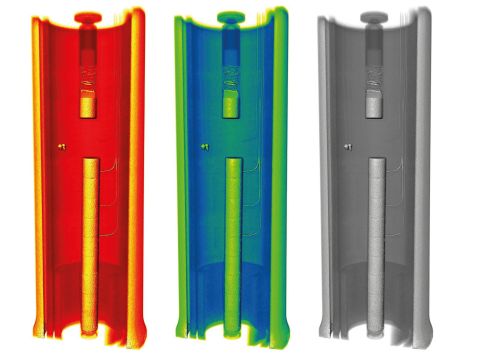MLZ is a cooperation between:
 > Technische Universität München
> Technische Universität München > Helmholtz-Zentrum Hereon
> Helmholtz-Zentrum Hereon
 > Forschungszentrum Jülich
> Forschungszentrum Jülich
MLZ is a member of:
 > LENS
> LENS > ERF-AISBL
> ERF-AISBL
MLZ on social media:

MLZ (eng)
Lichtenbergstr.1
85748 Garching
20.09.2019
Neutron CT as an imaging method for safer nuclear fuels

The image below shows a fuel rod in a titanium capsule showing individual fuel pellets. The neutron CT also showed bulging of the cladding generated during testing in the TREAT reactor. © Aaron Craft (INL)
The Idaho National Laboratory (INL) and the Heinz Maier-Leibnitz Zentrum (MLZ) have been collaborating for two years to establish digital neutron computed tomography at the INL for the development of safe nuclear fuels. For many decades, the INL has been developing safer and more efficient nuclear fuels for civil nuclear reactors. In order to establish safe operating limits, the performance of nuclear fuels must be determined. For example, prototypes of nuclear fuels are tested under extreme conditions in the Transient Reactor Test Facility (TREAT) of the INL – similar to a crash test in the automotive industry.
After the tests at TREAT, the disrupted fuel rods are examined in the neutron radiography reactor (NRAD) of the INL. Neutrons can be used in particular to investigate dense materials (e.g. uranium in nuclear fuels) that cannot penetrate X-rays. The neutron radiography process is also only a little sensitive to the gamma radiation emitted by the fuel. In this way, researchers can visualize the inner state of the test fuel non-destructively.
Dr. Aaron Craft of the INL and Dr. Burkhard Schillinger of the Heinz Maier-Leibnitz Zentrum (MLZ) have now, together with colleagues, developed a neutron CT system for the investigation of nuclear fuels. Setting up such a neutron CT system is a difficult task, as the electronics of the system can be damaged by the radiation if insufficiently shielded. An adapted version of the control system developed and used on the tomography system of the Heinz Maier-Leibnitz Research Neutron Source (FRM II) was installed at NRAD. This world’s first digital neutron CT can provide deeper insights into the properties of nuclear fuels.
The INL and the MLZ are also part of a global effort to develop low enrichment fuels for research reactors that currently require highly enriched fuel to deliver optimal research results (currently five reactors in the US and two in Europe). While the transition to low enriched fuels is a technical challenge and will continue for many years to come, the advances in analytical techniques mentioned here may accelerate the development of low enriched fuels for the conversion of these reactors.
MLZ is a cooperation between:
 > Technische Universität München
> Technische Universität München > Helmholtz-Zentrum Hereon
> Helmholtz-Zentrum Hereon
 > Forschungszentrum Jülich
> Forschungszentrum Jülich
MLZ is a member of:
 > LENS
> LENS > ERF-AISBL
> ERF-AISBL
MLZ on social media:


